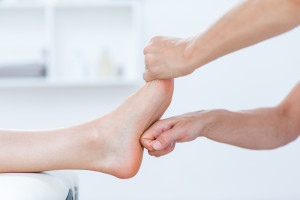
Super Bowl may be decided by a hidden factor: sore feet
Last fall, Broncos quarterback Peyton Manning was diagnosed with plantar fasciitis. While the veteran has played through multiple injuries— name an NFL quarterback who hasn’t— he is 39 years old and is the first to admit he doesn’t bounce back like he used to. A cure, according to the doctors, would require ‘two months on the beach’. So, with a treatment strategy of just managing the pain, Manning limped onto the field for his third Super Bowl appearance.
He’s not the only top athlete with a sore heel. Chicago Bulls center Joakim Noah; Albert Pujois, first baseman for the Los Angeles Angels; San Diego Chargers’ Antonio Gates; Pau Gasol of the Los Angeles Lakers . . . all share the diagnosis. The condition kept Pujois off first base, and it nearly kept Manning out of the Super Bowl.
Usually plantar fasciitis is self-healing but it takes time— months or even years. What professional athlete is willing to sit on the sidelines for that long?
While plantar fasciitis is nothing new, it seems to have become the diagnosis-du-jour among pro athletes. There are several theories as to why. One is that young players tend to specialize at a younger age. Back in the day, a talented youngster might play football and baseball and basketball, each in its season. Bode Miller, the World Cup champion and Olympic downhill skier, nearly became a professional tennis player. These days, the trend is to pick a sport and then stick with it— even at the ripe old age of 10 or 12.
This can cause overuse injuries. Repetitive pounding— repeating the same motions day after day, especially on a hard surface— takes its toll. Many young athletes can’t be bothered with stretching. They jump out on the field with cold feet, so to speak, priming themselves for a tear. Few trainers insist on heel-cord stretches (although that could change with the increase in publicity). Speed work-outs, plyometrics and hilly sprints, as well as running indoors on hard surfaces, don’t help the situation. The plantar fascia helps absorb shock. If there is excessive shock, the fascia takes a beating.
A Tear in the Sole
The plantar fascia is a long, thin ligament that runs from the heel towards the toes, supporting the arch. It’s meant to absorb the weight of the body, as well as the load while running and walking. If too much pressure is placed on the fascia, it becomes inflamed and tender. The ligamentous tissue may also tear.
If you have pain in the bottom of your foot, make an appointment to have it checked out.
Once the problem has been diagnosed, we can apply some clinical tools to help relieve pain and inflammation, including:
 anti-inflammatory drugs such as Motrin or Advil
anti-inflammatory drugs such as Motrin or Advil- shoe inserts to cushion the foot
- stretching exercises
- night splints that fit across the arch of your foot
- ice packs to be applied to the sole
- steroid injections
- radio frequency
- surgery
Plantar Fasciitis Healing Takes Time, Patience
In a perfect world, pain would be the limiting factor that kept us off our feet. A period of inactivity would give the fascia time to heal. But we don’t live in a leisurely society. Most of us need to get back to work, or working out.
In lieu of staying off your feet for six months (and losing muscle tone or gaining weight or not playing in the Super Bowl), we can help you recover with a multi-modal approach. Rest, change of activities and footwear, perhaps corticosteroids . . . . The treatment plan is dictated by your particular situation, the severity of the condition, lifestyle, and other factors.
Peyton Manning was fortunate. His doctors identified the problem immediately and started treatment. You may not be eligible for the Super Bowl, but we can do the same for you.











